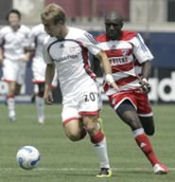Depending on which day it is, MLS commissioner Don Garber will tell you different benchmarks and timetables for expansion, as well as which cities are in the lead. A few weeks back, he said there was no timetable, and threw out a few cities he felt were in the lead.(click title to read more)
"San Jose is at the top of the list," Garber told me. "Then Philadelphia and the Pacific Northwest. The good thing about expansion is there is no deadline."
Fantastic. The fact is, MLS is nearing the end of it's drive to build the league's infrastructure. They say they are stopping at either 16 or 18 teams to "take a breather" for a host of plausible reasons. Besides the grueling political struggles they have grown tired of, rapid expansion isn't wise both financially and from a quality of play standpoint. The problem is, this will leave huge gaps in the footprint MLS has in this country. Soccer United Marketing, the wider-reaching marketing arm of MLS, will also be left out of several key markets. The scramble to win the lottery for the last three spots, which will have everything to do with what the ownership will be and nothing to do with which markets will be best for the growth of soccer in the US, will leave some important markets out in the cold. (click title to read more)
The solution to this would require MLS to take another major step in developing the game in this country. That would be creating a second division. With a second division, it would make it easier to attract investors to MLS. They wouldn't be required to construct expensive stadiums, their expansion fee would be much less than the $15 million Toronto FC paid last year, and they would have the financial stability and marketing power which comes with being a part of MLS. From there, any expansion to the first division would come from existing teams in the second division. They would have to meet tougher stadium requirements, have successful attendance figures and financial results, and then pay another expansion fee for the "economic promotion" to the top flight.
The right time to launch something like this would be when MLS expands to 16 teams and then takes that breather Garber talked about. For the sake of argument, let's say that San Jose, Las Vegas, and Seattle get teams (completely random). MLS would still be out of large markets like Philadelphia, Phoenix, and Atlanta. The league has talked to investor groups in the past about having teams in those cities. Most of those groups need a lot of public assistance to build a suitable MLS stadium. A few USL-1 teams like Charleston and Atlanta have privately funded small soccer stadiums without affluent ownership groups. This would be much easier to accomplish than the prolonged political dances and backroom deals associated with building a 20-25k stadium.
USL
If this were to be successful, at least handful of USL-1 teams (and maybe a USL-2 team like Charlotte) would have to jump ship and become charter members of the new division. USL has a goal to be a competitor of MLS, but that's just not going to happen with SUM's monopoly on top flight soccer. USL could go on to form regional leagues like USL-2, which is based in the east. They do a great job in player development, and can continue to do so with the PDL and semi-pro leagues.
Absorbing those teams would be a little tricky. For those of you hoping for a quick death to MLS's single entity structure, it'll be a long time before that will come to an end. For this to work, the players would have to sign with the league. However, the ownership groups would probably have to remain separate. Current MLS owners probably don't want to absorb any more losses. Also, a prime target for this would be Montreal. They are actually set up as a non profit organization. Their new stadium is being funded partly by grants given to such groups. Jumping into a system set up like MLS would negate their status and could cost them millions. So, something would need to be worked out. In return for joining, those teams would get a disciplined cost structure in exchange for long term security.
USL teams I feel would make the initial switch to MLS: Rochester, Montreal, Atlanta, Charleston, Portland, Vancouver, Puerto Rico, and Carolina.
Relevancy
The key to pulling this off is to prevent the stigma that all it would be is a minor league. I'll go into the semantics of promotion/relegation later, but if that were to ever have a chance of happening, MLS-2 would need to be both economically viable and relevant. There's also the fact that most teams would never earn economic expansion to MLS-1, so there would be good cause to make this division prestigious enough to attract investors.
My idea for this would be quite revolutionary. After the initial one or two seasons (shakedown period), I would begin having the top two teams earning a place in the MLS Cup playoffs. The division would be immediately relevant and would reward the top two teams with a home game against one of the top two teams in MLS-1. It would also create a David and Goliath situation which is always interesting television.
Also, they could start running a league cup during the preseason in warmer weather cities. They could maybe expand that in future years and give the winner a place in Superliga. Throw in the usual rounds of US Open Cup action and all the MLS-2 teams would have some competitive games against the first division clubs and a chance to win some of the biggest trophies in American soccer.
Economic Expansion
So how would economic expansion into MLS-1 work? Well, the clubs would first have to get the approval from the league. Teams would first need to show superior fan support, have control over key revenue streams in their stadiums, and have set up both a reserve team which competes with MLS-1 sides and a youth pyramid structure with the potential to produce home grown players. Then they would need to pay a promotion fee, maybe over a number of years, and then they are in.
The key to this is that MLS-1 would be getting strong ownership groups, not someone with a bag of money unaware of what they are getting into. This kind of expansion would work well in expanding MLS-1 to 18, and then maybe 20 teams.
Second Division Setup
MLS has over a decade of experience keeping afloat a fledgling league, so it knows the tricks of the trade. This will come in handy during the first few years of MLS-2. For instance, there would have to be an unbalanced schedule to save money on travel costs. With a little luck, it could look something like this after a few years:
Philadelphia, Montreal Impact(USL-1), Rochester Raging Rhinos(USL-1), Carolina Railhawks (USL-1), Atlanta Silverbacks (USL-1), Charleston Battery (USL-1), Puerto Rico Islanders (USL-1), Portland Timbers (USL-1), Vancouver Whitecaps (USL-1), Phoenix, Milwaukee, Miami FC (USL-1)
(Assuming the three cities I mentioned earlier were already in MLS-1, I just threw in the USL teams I think would make the initial jump with some strong candidate cities.)
Promotion/Relegation?
If you look around the world, nearly every national league has a ladder system with promotion and relegation. For the most part, this was brought about because the supply of top fight capable clubs exceeded the demand when those leagues were formed over a century ago. It's nearly impossible to set something like that up from scratch here. Believe me, if they were forming the top flight in England today, it would look more like the NFL than the EPL. Financing would be easier and the owners would be assured to rake in gobbs of money without worrying about relegation. Granted, the ladder system is an important part of the footballing culture in those nations, but it was brought about in another time. For American soccer, you just couldn't relegate Red Bull New York to the USL to bring MLS to Puerto Rico. However, there are a few more modern examples of soccer leagues setting up pro/reg.
The best example of how to set up a second division is the way the Japan's J-League did it in 1999. Essentially, there was already a great number of serious amateur and semi-pro clubs in the country. The J-League invited the ones who qualified to form J-2 with immediate promotion and relegation. This allowed some of the smaller market clubs time to build and they are now mainstays in J-1. While this kind of setup would make things very interesting in MLS, I just don't see it happening without a successful second division already established. Even then, teams would still need to economically qualify for top flight status and probably pay a one-time promotion fee.
Other Benefits
Besides providing a breeding ground for future top flight clubs, a second division would benefit American soccer in many other important ways. First off, MLS-2 would be a heck of a lot more visible than USL-1 is right now. First division clubs would have better access to game footage and the scouting network which the league is currently building would be greatly enhanced. MLS-1 teams could loan out some of their younger players to MLS-2 teams and vice versa. There would also be more coaching positions in MLS for prospective managers to prove themselves.
Conclusion
The expansion sweepstakes are tough and could yield some peculiar results. There are just too many prospective markets where MLS could be successful. Why leave up to political circumstance which fans are blessed with teams? A second division would be the answer to enlarge MLS's footprint in the US and Canada. It's the next logical progression in establishing a world class infrastructure, anyway. When the mickey mouse antics of growing the league to 16 teams is finally accomplished, they should give this idea a shot.
You are here: Home > MLS > How To Expand MLS
Monday, June 04, 2007
How To Expand MLS
Subscribe to:
Post Comments (Atom)



















0 Comments:
Post a Comment